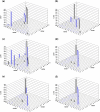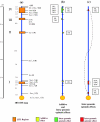Dissection of QTL effects for root traits using a chromosome arm-specific mapping population in bread wheat
- PMID: 21153397
- PMCID: PMC3037480
- DOI: 10.1007/s00122-010-1484-5
Dissection of QTL effects for root traits using a chromosome arm-specific mapping population in bread wheat
Abstract
A high-resolution chromosome arm-specific mapping population was used in an attempt to locate/detect gene(s)/QTL for different root traits on the short arm of rye chromosome 1 (1RS) in bread wheat. This population consisted of induced homoeologous recombinants of 1RS with 1BS, each originating from a different crossover event and distinct from all other recombinants in the proportions of rye and wheat chromatin present. It provides a simple and powerful approach to detect even small QTL effects using fewer progeny. A promising empirical Bayes method was applied to estimate additive and epistatic effects for all possible marker pairs simultaneously in a single model. This method has an advantage for QTL analysis in minimizing the error variance and detecting interaction effects between loci with no main effect. A total of 15 QTL effects, 6 additive and 9 epistatic, were detected for different traits of root length and root weight in 1RS wheat. Epistatic interactions were further partitioned into inter-genomic (wheat and rye alleles) and intra-genomic (rye-rye or wheat-wheat alleles) interactions affecting various root traits. Four common regions were identified involving all the QTL for root traits. Two regions carried QTL for almost all the root traits and were responsible for all the epistatic interactions. Evidence for inter-genomic interactions is provided. Comparison of mean values supported the QTL detection.
Figures


Similar articles
-
Integrated genetic map and genetic analysis of a region associated with root traits on the short arm of rye chromosome 1 in bread wheat.Theor Appl Genet. 2009 Sep;119(5):783-93. doi: 10.1007/s00122-009-1088-0. Epub 2009 Jun 21. Theor Appl Genet. 2009. PMID: 19544051 Free PMC article.
-
Dosage effect of the short arm of chromosome 1 of rye on root morphology and anatomy in bread wheat.J Exp Bot. 2010 Jun;61(10):2623-33. doi: 10.1093/jxb/erq097. Epub 2010 May 5. J Exp Bot. 2010. PMID: 20444906 Free PMC article.
-
Sodium exclusion QTL associated with improved seedling growth in bread wheat under salinity stress.Theor Appl Genet. 2010 Sep;121(5):877-94. doi: 10.1007/s00122-010-1357-y. Epub 2010 May 19. Theor Appl Genet. 2010. PMID: 20490443
-
Genetic dissection for seedling root-related traits using multiple-methods in bread wheat (Triticum aestivum L.).Theor Appl Genet. 2025 Mar 7;138(3):66. doi: 10.1007/s00122-025-04847-6. Theor Appl Genet. 2025. PMID: 40053141 Review.
-
Mapping QTL for agronomic traits in breeding populations.Theor Appl Genet. 2012 Jul;125(2):201-10. doi: 10.1007/s00122-012-1887-6. Epub 2012 May 22. Theor Appl Genet. 2012. PMID: 22614179 Review.
Cited by
-
Traits and QTLs for development of dry direct-seeded rainfed rice varieties.J Exp Bot. 2015 Jan;66(1):225-44. doi: 10.1093/jxb/eru413. Epub 2014 Oct 21. J Exp Bot. 2015. PMID: 25336682 Free PMC article.
-
Small "Nested" Introgressions from Wild Thinopyrum Species, Conferring Effective Resistance to Fusarium Diseases, Positively Impact Durum Wheat Yield Potential.Plants (Basel). 2021 Mar 19;10(3):579. doi: 10.3390/plants10030579. Plants (Basel). 2021. PMID: 33808545 Free PMC article.
-
Association mapping for root architectural traits in durum wheat seedlings as related to agronomic performance.Mol Breed. 2014;34(4):1629-1645. doi: 10.1007/s11032-014-0177-1. Epub 2014 Nov 27. Mol Breed. 2014. PMID: 25506257 Free PMC article.
-
A scanner system for high-resolution quantification of variation in root growth dynamics of Brassica rapa genotypes.J Exp Bot. 2014 May;65(8):2039-48. doi: 10.1093/jxb/eru048. Epub 2014 Mar 6. J Exp Bot. 2014. PMID: 24604732 Free PMC article.
-
Genetics and genomics of root system variation in adaptation to drought stress in cereal crops.J Exp Bot. 2021 Feb 24;72(4):1007-1019. doi: 10.1093/jxb/eraa487. J Exp Bot. 2021. PMID: 33096558 Free PMC article. Review.
References
-
- Böhm W. Methods of studying root systems. New York: Springer-Verlag; 1979.
-
- Braun HJ, Payne TS, Morgounov AI, Ginkel Mv, Rajaram S. The challenge: one billion tons of wheat by 2020. In: Slinkard AE, editor. Proceedings of the 9th international wheat genetics symposium. Saskatoon, SK: University Extension Press, University of Saskatchewan; 1998. pp. 33–40.

